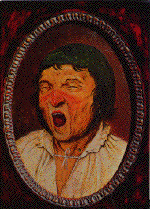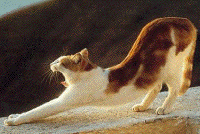La présence éventuelle d'une publicité ci-dessus est insérée par le routeur du "mailing-list" indépendamment de mes choix en compensation de la gratuité de son service Dr O Walusinski baillement.com baillement.info yawning.info

mercredi 1er janvier 2003 la lettre d'information du site baillement.com N°15 Si vous ne voyez pas les images, cliquez ici pour lire cette lettre dans votre navigateur. If you cannot see pictures below, to view the email in your web browser click here baillement.com est libre d'accès, base documentaire pour comprendre, chercher, travailler
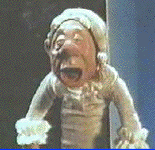
le bâillement chez Disney Bonne Année Happy New Year
- The Yawning Man (Danny Kyle)
- Mhmhmhmhmhmh
- Mhmhmhmhmh
- I'm the yawning man, the yawning man
- I yawn, I yawn, I yawn
- With my yawning song I yawn along
- And I sing my yawning song
- And I snuggle in quite warm, I won't come to any harm
- And I sing my yawning song
- And I go to bed and I cover up my head
- And I sing my yawning song
- And my nightie it is blue and Teddy he comes too
- And I sing my yawning song
- And my jammies they are red and I get myself to bed
- And I sing my yawning song
- And I cover up my head and my prayers they re all said
- And I sing my yawning song
- Goodnight, goodnight, don't let the wee bugs bite
- And I sing my yawning song
- So goodnight and sweet repose, lie on your back don't squash your nose
- And I sing my yawning song

Remerciements à Raymond C. Rowe , d'AstraZeneca UK, qui a inspiré ce commentaire Thanks to Raymond C. Rowe , AstraZeneca UK
- La question : que dit un rat de laboratoire à un autre rat ?
- La réponse : j'ai bien entrainé mon chercheur; à chaque fois que j'appuie sur le bouton il me donne à manger !
- Aucun autre animal de laboratoire n'a permis de collecter autant de données physiologiques que le rat. Le rat sert de modèle pour de nombreuses maladies humaines, et permet de comprendre la physiologie. En fait, chacun de nos organes peut être étudié chez le rat, tant par ses pathologies qu'en expérimentant des mutations. Avec six portées par an de 6 à 14 descendants, la reproduction prolixe du rat a permis de sélectionner des lignées particulièrement adaptées aux travaux de laboratoire. En 1906, le Wistar Institute commercialisait la première lignée; puis apparurent le Sprague Dawley croisement d'une femelle de Wistar et d'un mâle inconnu. En janvier 2002, est né le Rat Resource and Research Centre (RRRC), chargé de distribuer des lignées parfaitement génétiquement caractérisées (standard, hybride, muté) qu'elles soient vivantes, sous forme d'embryons congélés, de gamètes ou de tissus isolés. Que serait l'étude du bâillement et de l'érection sans le rat? Hommage au rat de laboraoire.
- Question: What did one lab rat say to the other?
- Answer: I've got my scientist so well trained that every time I push the buzzer, he brings me a snack!
- Rat models provide more physiological data than
perhaps any other experimental animal. "Rats serve as
very important animal models of many human diseases and
conditions and are one of the most important experimental
animals in studies related to understanding physiological
processes and health concerns in humans. Almost any organ
system in humans can be studied using specific rat
strains or mutants "(Vaitukaitis, J. (2002) NIH News
Release, January 28, National Institutes of Health,
Bethesda, USA). With a litter size of between six and 14
pups, and six litters per year, the population can
increase dramatically. The fisrt colony established at
the Wistar
Institute in Philadelphia in 1906 has contributed to
more strains of rat than any other single line. Sprague
Dawley rats originated from Wistar females crossed
with a hybrid male of unknown origin. Rat
Resource and Research Centre (RRRC) is born in jan
2002, with the aim of establishing a centre for the
distribution of high quality, well-characterized, inbred,
hybrid and mutant rats to investigators. Rats will be
distributed to investigators either alive or as
cryopreserved germplasm or tissues. What will be the
research about yawning without the rat?
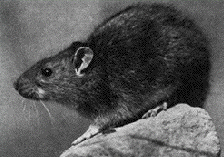
les rats qui bâillent Two sublines of Sprague-Dawley rats which differ in their spontaneous yawning frequencies also differ in their responses to drugs with well known yawn-inducer activities Deux lignées de rats Sprague-Dawley, différentes par la fréquence de leurs bâillements diffèrent aussi par leur susceptibilité aux psychotropes
- Les variations de concentrations et le turn-over de nombreux neurotransmetteurs, leurs synthèses et leurs dégradations, leurs densités dans les synapses cérébrales sont génétiquement déterminées. Il a été suggéré que les variations de concentrations en neuromédiateurs cérébraux étaient principalement liées à ces variabilités génétiques. D'importantes variations comportementales et susceptibilités aux psychotropes semblent en être la conséquence directe. L'équipe mexicaine de Ruth Urba-Holmgren et une équipe du CNRS d'Orléans ont sélectionné des lignées de rats spontanément grands ou petits bâilleurs et démontré leur plus ou moins grande susceptibilité aux psychotropes. Ils ont montré les effets stimulants ou inhibiteurs de doses variables de drogues dopaminergiques ou cholinergiques. Leurs travaux sont présentés maintenant sur le site.
- It is known that the concentrations and turnover rates of several neurotransmitters, the activities of their synthesizing or degradative enzymes and their receptor densities in the brain show genetic variations. It have suggested that some changes in regional neurotransmitter activities in the brain might be due to primary differences in their underlying genetic mechanisms, whereas other might be secondary to imbalances in neurotransmitter interactions. Strain differences in behavioral expression or in sensitivity to drugs may be one major consequence of these changes. Elicitation of yawning is mainly the result of an interaction, somewhere in the brain, between inhibitory dopaminergic and excitatory cholinergic influences on the built-in motor program for yawning. These works are now presented on the website.
- Doger E, Urba-Holmgren R, Eguibar JR, Holmgren B GABAergic modulation of yawning behavior.Pharmacol Biochem Behav 1989 Oct;34(2):237-40
- Eguibar JR et Moyaho A Inhibition of grooming by pilocarpirpine differs in high-and low yawning sublines of Sprague-Dawley rats. Pharmacoology Biochemistry and Bebavior 1997; 58: 2; 317-322
- Diaz-Romero M, Eguibar JR, Moyaho A Bombesin decreases yawning in high-and low yawning sublines of Sprague-Dawley Pharmacoology Biochemistry and Bebavior 2002;71;103-109
- Houston J Yawning and Penile Erection induced in Rats by Cortical Spreading Depression Nature 1971; vol 232; p274-275
- Urba-Holmgren R, Trucios N, Holmgren B, Eguibar JR, Gavito A, Cruz G, Santos A Genotypic dependency of spontaneous yawning frequency in the rat Behav Brain Res 1990 Oct 30;40(1):29-35
- Urba-Holmgren R, Santos A, Holmgren B, Eguibar JR Two inbred rat sublines that differ in spontaneous yawning behavior also differ in their responses to cholinergic and dopaminergic drugs Behav Brain Res 1993 Sep 30;56(2):155-9
- Urba-Holmgren R, Holmgren B, Rodriguez R, Gonzalez RM Serotonergic modulation of yawning Pharmacol Biochem Behav 1979 Sep;11(3):371-2
- Urba-Holmgren R, Gonzalez RM, Holmgren B Is yawning a cholinergic response? Nature 1977 May 19 267 (5608): 261-2 et commentaires Cholinergic link in yawning A Cowan Nature 12/01/78 271 p187-188
- Urba-Holmgren R, Holmgren B, Leon BA, Ugarte A Age-dependent changes in serotonergic modulation of yawning in the rat. Pharmacol Biochem Behav 1992 Oct;43(2):483-6
- Moyaho A, Valencia J Grooming and Yawning
Trace Adjustment to Unfamiliar Environments in Laboratory
Sprague-Dawley Rats (Rattus norvegicus) Journal of
Comparative Psychology, 2002, Vol 116, N°3, 263-269
(à venir sur le site)
- Wolter Seuntjens (NL) m'a aimablement confié une reproduction de ce tableau de Pieter Brueghel the Elder 1527-1569
- Le bâilleur, Yawning Man or De Gaper, exposé aux Musées Royaux des Beaux-Arts à Bruxelles
- Après que Marsden CD ait publié en 1976 une série de cas de dystonie oro-mandibulaire et baptisé ce trouble «Brueghel's Syndrome» en interprètant le tableau ci-contre, est née une polémique : Brueghel a -t-il peint une dystonie ou un bâillement ?
- Vous pouvez maintenant voir ce tableau en grand format, lire l'article de Marsden et découvrir l'usage du bâillement pour lutter contre la dystonie oro-mandibulaire (la toxine botulique est maintenant le traitement de référence), lire les arguments médicaux et picturaux de Stephen G. Reich and Robert L. Ruff, auteurs de Yawning Man or Blepharospasm-Oromandibular Dystonia ? «Brueghel's Syndrome» Revisited. Le syndrome de dystonie blepharospasme-oromandibulaire a été décrit pour la première fois par Meige (1910) . Visiter un site consacré à l'Oromandibular Dystonia .
- Idiopathic blepharospasm is well recognised, but
idiopathic oromandibular dystonia is not. Both
blepharospasm and oromandibular dystonia may occur in
patients with known diseases of the basal ganglia such as
those that cause symptomatic torsion dystonia, or may be
produced by neuroleptic drugs. Hence the suggested title
'blepharospasm-oromandibular dystonia syndrome', which
may have been described first by Meige
(1910). What Pieter
Brueghel the Elderhad in mind in the mid-16th
century, when he painted the face of a man showing the
eyes tightly closed and the mouth widely open, may never
be known. Historians of art contend that this painting
depicts a huge yawn and have titled this work
Yawning Man or De Gaper. Neurologists have offered
alternative ideas; Marsden
CD note the similarity of this painting to the
syndrome of blepharospasm-oromandibular dystonia and
suggested the eponym "Brueghel's
syndrome". Although Brueghel's works of art
reveal that he had a fascination with human physiognomy,
both normal and pathologic, Marsden's claim that Brueghel
"clearly recognized the syndrome" may be an
overinterpretation of this unsigned, undated, and
untitled painting. See a web site about Oromandibular
Dystonia .
- Synapse Web est un passionnant site web de l'Université de Boston, consacré à la structure de la synapse et ses fonctions. Vous y trouverez des informations sur l'ultra-structure des différentes parties du système nerveux avec des développements particuliers consacrés à la synapse. Synpase Web apporte également une introduction à la neuranatomie, à la structure des dendrites, axones et autres astrocytes. Le site propose également un extraordinaire atlas de neurocytologie ultrastructurale conçu par Joseph Spacek, base de données de référence consacrée non seulement au neurone et à la glie, mais aussi aux vaisseaux, méninges et aux différentes pathologies neurologiques. Synpase Web est développé avec l'aide du Human Brain Project, dans le but de stimuler le développement de bases de données en neurosciences.... ce que baillement.com souhaite être pour le bâillement!
- Synapse Web is a fabulous web site of the Laboratory of Synapse Structure and Function at Boston University. Here, you will find information on the ultrastructure of the nervous system at all levels, with a particular emphasis on synapses. Synapse Web includes introductory information on brain anatomy, and on the structure of dendrites, axons, astrocytes and synapses. The site also hosts an extraordinary Atlas of Ultrastructural Neurocytology by Josef Spacek, a reference resource in which you can find ultrastructural descriptions not only of neurons and glia, but also of blood vessels, the meninges and the diseased brain. Synapse Web is supported by the Human Brain Project as part of their efforts to stimulate the development of neuroscience databases ... what yawning.info hoppe to be for yawning !
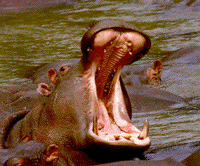
Yawning and penile erection: central dopamine-oxytocin-adrenocorticotropin connection Argiolas A, Melis MR, Gessa GL Ann N Y Acad Sci 1988;525:330-7
- L'érection pénienne et le bâillement sont deux comportements différents qui se produisent fréquemment simultanément soit physiologiquement, soit expérimentalement. Compte-tenu de son évidente implication dans la reproduction, l'érection doit pouvoir avoir lieu en parfaite vigilance et hors stress. Il est pertinent de se rappeler que le bâillement associé aux étirements est une survivance, tout au long de l'évolution des espèces, d'un comportement archaïque dont la finalité est la stimulation de la vigilance. En particulier, le rôle du bâillement est de stimuler l'attention lors de l'envie de dormir ou de fatigue, face à un danger ou dans certaines circonstances d'interactions sociales. Des épisodes de bâillements répétés associés à des érections peuvent être provoqués chez le rat et d'autres animaux de laboratoire par injections IV de petites doses d'agonistes dopaminergiques, comme l'apomorphine, par injection centrale d'ACTH, de MSH, et d'autres neuropetides, et par injection dans le LCR. La capacité de ces différents neuro-médiateurs d'induire, tous, les mêmes comportements prouve qu'il existe un lien entre dopamine, oxytocin, et ACTH dans le sytème nerveux central. Cet article clarifie les mécanismes neuronaux sous-tendant le comportement de bâillement-érection et démontre pour la première fois l'implication séquentielle de ces trois neuromédiateurs au niveau du noyau paraventriculaire de l'hypothalamus.
- Penile erection and yawning are two different
behavioral patterns that often occur concomitantaly in
physiological and experimental conditions. While the
importance of penile erection in reproduction does not
need to be further stressed. It is pertinent to recall
that yawning, alone or associated with stretching, is
considered to be an ancestral vestige surviving
throughout evolution, that subserves the purpose of
arousal. In particular, the role of yawning could be
that of increasing attention when sleep is imminent due
to fatigue or boredom but cannot be engaged in, as in
face of a danger or social circumstances. Repeated
episodes of yawning and penile erection can be induced in
rats and other experimental animals by the systemic
administration of low doses of dopamine (DA) agonists,
such as apomorphine, by the central administration of
adrenocorticotropin (ACTH), alpha-melanocyte-stimulating
hormone (a-MSH) and related peptides, and by the
intracerebroventricular (i.cv.) injection of oxytocin..
The capability of the above substances to induce such
similar symptomatology raises the possibility that a
neuronal link exists among DA, oxytocin, and ACTH in the
central nervous system. The results of the experiments
presented in this article, which were performed with the
aim of demonstrating the existence of such a link and to
clarify the neural mechanisms underlying the expression
of yawning and penile erection as well, provide evidence
for the first time that DA, oxytocin, and ACTH act in the
PVN nucleus of the hypothalamus in a sequence to induce
these behavioral responses.
- Le Dr Éric Mullens est médecin
généraliste, spécialiste de la
pathologie du sommeil et de la vigilance dans le Tarn, et
membre de la Société française de la
recherche sur le sommeil. En 1991, il a
créé le laboratoire de sommeil qu'il dirige
à la fondation Bon Sauveur d'Alby. Il est aussi un
des premiers à avoir une consultation de sommeil
en cabinet de ville; son
site internet sur le sommeil fait
référence en France. Il vient
d'écrire un livre récemment paru :
Apprendre
à dormir, leçons de sommeil .
Son domaine d'activité s'étend sur une large variété d'actions de sensibilisation et de formation sur le thème important du sommeil dans le milieu scolaire, médical et dans le monde du travail;
Apprendre à dormir, leçons de sommeil par le Dr Eric Mullens commander son livre
Hémiplégie et bâillements toute la littéraure de 1879 à nos jours publiée en France et aux Amériques est en intégralité sur le site manque la littérature en allemenand
- La lettre du site N° 12 du 1er octobre 2002 présentait la thèse du Dr Etienne Quoirin conscrée à la parakinésie brachiale (ou hémipandiculation) apparaissant dans certains cas d'hémiplégies, déclenchée par le bâillement. Voici maintenant un article paru dans la revue Sud-Américaine Medicina de Buenos Aires, en espagnol avec sa traduction en français :
- The yawning and stretching sign in hemiplegics Lanari A, Delbono O Medicina (B Aires) 1983; 43(3); 355-6
- Sur ce thème, un article ancien de 1946 est souvent cité : Yawning and associated phenomena Heusner AP Physiological Review 1946; 25; 156-168. De larges extraits sont maintenant présentés.
- D'un long article de 36 pages paru dans Brain en 1923, sont extraits les passages relatifs au bâillement dans l'hémiplégie:
- On certain tonic or postural reflexes in hemiplegia with special reference to the so called "associated movements" Walshe FMR; Brain, 1923; 46; 1-37
- Enfin, la seule observation du
phénomène inverse -la mobilisation passive
d'un bras paralysé par la poliomyélite
déclenche des bâillements - rapportée
par D Furtado de Lisbonne en 1951 est aussi
présentée. Provocation
spinale d'un réflexe de bâillement D
Furtado Revue d'Oto Neuro Ophtalmologie janvier 1951; T
23; N°1
- Les revues scientifiques sont pléthore. Vivant
essentiellement des abonnements des bibliothèques
scientifiques et universitaires du monde entier, leurs
tirages excèdent rarement 5000 exemplaires. Les
coûts d'abonnement sont
élévés. Les éditeurs se
plaignent du photocopiage qui a lieu dans les
bibliothèques. La documentation sur internet est
d'un coût prohibitif que ce soit auprès du
CNRS-INIST ou des revues anglo-saxones de 15 à 50
$ par article. Afin de remédier à cet
état de fait, et essayez d'enrayer la
"publicationnite aigue ou chronique", baillement.com a
souscrit, en 2001, comme plus de 30 000 autres
chercheurs, scientifiques, ou médecins à
une convention afin de créer une nouvelle forme
d'édition d'accès libre et gratuit. Soumise
aux mêmes règles éditoriales qui
siéent à une édition internationale
rigoureuse, la Public Library of Science mettra en
ligne ses premiers articles en juin 2003.
L'originalité vient du financement. Ce sont les
auteurs de publications ou les organismes de recherche
qui les emploient qui paieront de 200 à 500 $ pour
voir les travaux publiés sur le net et en
téléchargement libre et gratuit. Indexez
dès maintenant cette adresse, à visiter
sans tarder, dans les favoris de votre navigateur!
Autres documents mis en ligne ce mois-ci :
- Physiologic variations of the internal jugular vein surface, role of the omohyoid muscle, a preliminary echographic study Patra P
- Very young infants yawn or cry after watching animated programs K Mizukami
- A critical view of the yawn-sigh as a voice therapy technique Boone DR, McFarlane SC
- Frequencies and contexts of gape yawn displays of free-ranging Patas Monkeys EL Zucker
- Cerebrospinal fluid flow; physiology of respiration-related pulsation Schroth G
- stretchings and yawnings induced by adrenocorticotrophic hormone GL Gessa 1966
- stretching and yawning movements after intracerebral injection of ACTH GL Gessa 1967
- Yawning and penile erection induced in rats by cortical spreading depression Houston J
- Yawning and associated phenomena Heusner AP 1946
- On certain tonic or postural reflexes in hemiplegia with special reference to the so called "associated movements" Walshe 1923
- Drugs affecting dopamine neurons and yawning behavior Mogilnicka E, Klimek V
- Role of adrenergic neuronal activity in the yawning induced by tacrine in rats Kimura H et all
- Paraventricular nucleus lesion prevents yawning and penile erection induced by apomorphine and oxytocin but not by ACTH in rats Argiolas A
- Interaction of cholinergic and dopaminergic inflences en yawning behavior Holmgren B
- Hypophysectomy prevents yawning and penile erection but not hypomotility induced by apomorphine Serra G
- The yawning and stretching sign in hemiplegics Medicina (B Aires) Lanari A, Delbono O
- The influence of age, sex, rank on yawning behavior in two species of macaques Troisi A, Aureli F
- Inhibition of social behavior in chimpanzees under high-density conditions Aureli F, de Waal FB
- Contribution à l'étude des bâillements hystériques Nouvelle iconographie de La Salpêtirère1890 GE Gilles de la Tourette
-
le bâillement dans les médias: - Ecouter une interview recueillie par Charles Trahan pour Radio Canada et diffusée le 28 novembre 2002
- Lire la chronique de Martin Winckler consacrée au baillement sur France Inter le 8 octobre 2002
Résultats du sondageau 30 décembre 2002
-
Nombre de questionnaires remplis : 656 - Combien de fois bâillez-vous par jour ? <5 = 27,3%.. 5-10 = 26,1%.. 10-15 = 14;2%.. 15-20 = 9,5%.. >20 = 23%
- Ressentez-vous des baillements excessifs ?
- 76,8% = non, tant
mieux
25,5% = oui et je ne sais pas pouquoi - 5,9% = oui et je prends des antidépresseurs
- 1,2% = oui et je prends
des anti-épileptiques
5,2% = oui et je prends d'autres médicaments
2,7% = oui et j 'ai des troubles neurologiques
2,3% = oui et j 'ai des troubles hormonaux
3.8% = oui et j 'ai des tics moteurs
2% = oui et j 'ai des tocs - déclenchez-vous facilement le bâillement d'autrui ? 73,9%
- êtes-vous sensible au bâillement d'autrui ? 75%
« Celui qui n'a comme seul outil qu'un marteau a tendance à considérer tous les problèmes comme des clous » Mark Twain
baillement.com baillement.info yawning.info écrits et réalisés par le Dr O Walusinski
Voici le nombre d'abonnés à cette lettre : courriel à adresser lire les lettres précédentes d'information du site
